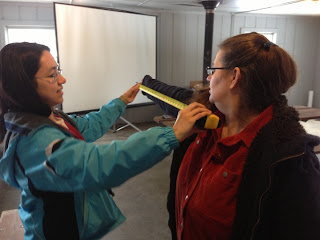The training included various opportunities to learn about the curriculum. While this is SCIENCE, it includes geography, literature, math, art, physical education, and other components. We worked in teams to figure out various bird related sayings and drawings.
We also compared the anatomy of birds to humans. To look at heart rate, we took our own heart rates while resting, exercised for a minute, and then took our heart rate again. We compared this to the heart rate of birds.
There were materials and resources to learn about the anatomy of birds. It took me back to a zoology class from my undergraduate degree.
We looked at bones, feathers, skulls, etc.
As groups we also plotted bird migration.
We specifically looked at the Wood Thrush and the Swainson Thrush and compared the two. Good questioning skills were modeled to help us draw conclusions about what we were learning rather than just directly giving us the information directly.
After lunch we went for a bird hike. It's great to know that we can still go on bird hikes without being able to quickly ID birds we encounter. Many helps and suggestions were given for bird hikes. One interesting find from a naturalist at Merry Lea Environmental Learning Center was snowfleas!
We thought about checking the Wood Duck boxes for Screech Owls but stopped short at the water.
Many birds were out and about, such as bluebirds.
This was a fun activity to represent how different types of beaks are useful in procuring specific foods. I even caught the popcorn with the funnel, simulating a flying bird that might catch an insect in flight. I used my mad chopstick skills (used to live in Japan!) for finding worms in the oatmeal.
We learned about resources to borrow materials for classes, websites, and groups that work toward birding education.
We simulated feeding worms to baby birds too. It's easy to see how some babies don't make it.
Who is this for? Anyone who is interested in learning more about birds! It is also applicable to those who like to teach formally or informally. We had preschool, daycare, homeschool, middle school, and college teachers in the group. We also had people interested in learning about birds and those who needed educational hours for Indiana Master Naturalists, as well as environmental educators. Many of us fit in several of the categories. I recommend this workshop! At only $20, which includes a manual full of resources, this is a steal. It's fun and educational. Professional Development and graduate credit opportunities are also available.















